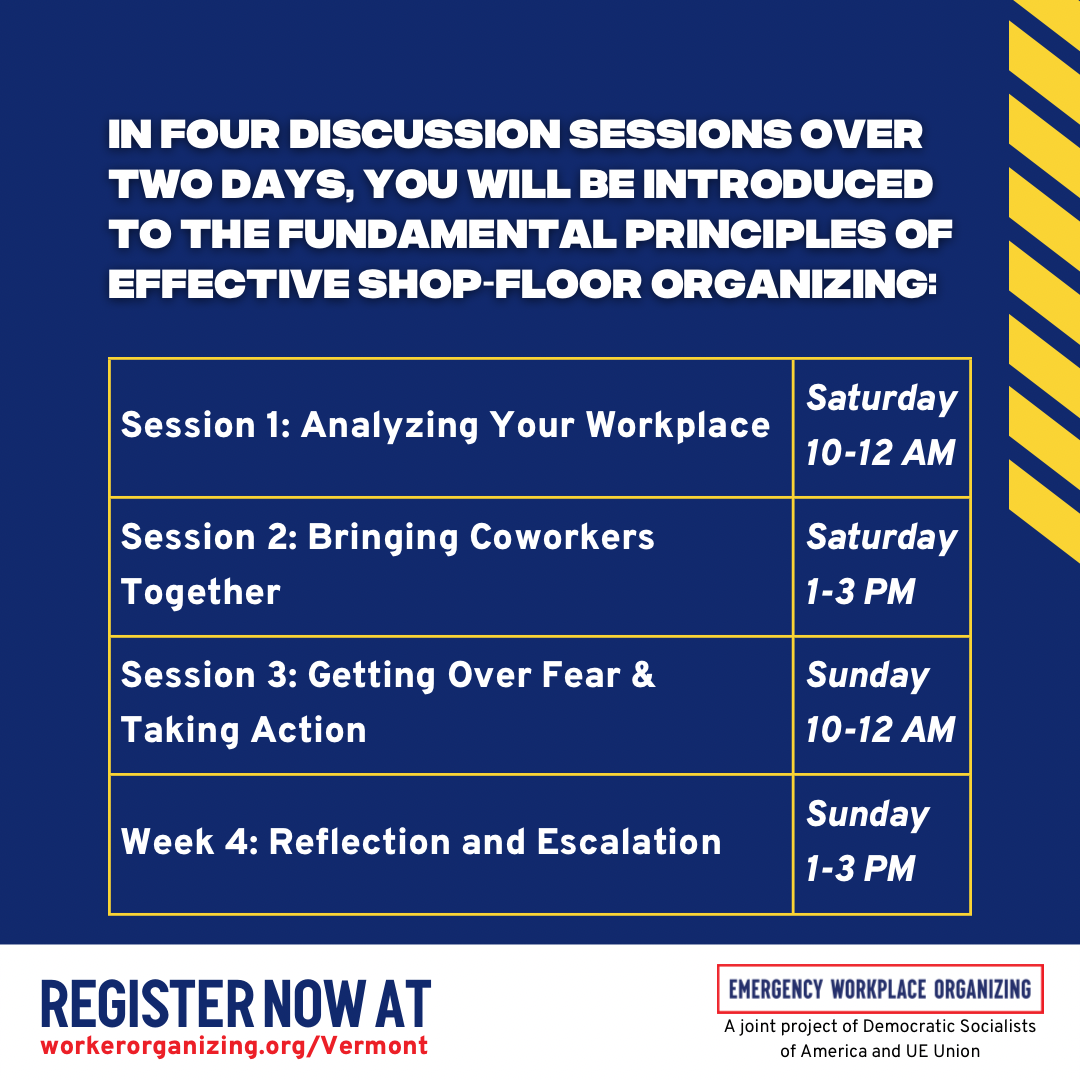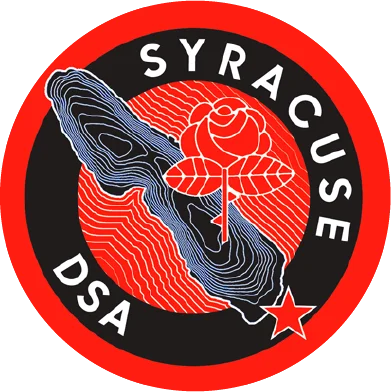

Vermont Workplace Organizer Training!
Vermont Workplace Organizer Training is coming to the Old Socialist Labor Hall in Barre, VT! Join us on October 8th and 9th for a series of four workplace organizing sessions starting at 10am each day. The best thing that any of us can do for the cause of organized labor is to build a militant, worker-driven union in our own workplace. We have seen the successes of the union building in Starbucks locations across the country and we need to keep building on that momentum in every sector.
Check out the sessions that will be offered and find out more here.

Sign up here!


Inside the Producers' Studio with Jack and Amy
Let's go inside the RPM producers' studio. In this episode, Jack and Amy discuss the founding of Revolutions per Minute, our approach to making socialist radio, and what we think other DSA chapters or political groups could learn from our four years of experience in broadcasting. We pay tribute to our comrade Lee Ziesche who is leaving NYC after many years of living and organizing in our community. Listen to Lee's very first appearance on our show and hear us discuss from a producers' angle what she has contributed to our work.
Pitch an idea to Revolutions per Minute: bit.ly/pitch2RPM
Join the RPM collective: bit.ly/RPMJoinForm


Protect Trans Kids
We demand that trans and queer kids be protected. We support any teachers and administrators who are working to keep them safe.





Pasco-Hernando DSA Condemns Ron DeSantis
We condemn our white nationalist governor and his pattern of straight up racist policies attacking immigrants. As democratic socialists, we recognize that migrants experience the most damning and direct crimes of the neoliberal capitalist system. Militarized borders, xenophobic/racist immigration laws, and an abusive prison industrial complex aim to dehumanize and marginalizes immigrants, functioning to both suppress wages and divide the working class.
We seek to abolish these and any barrier to the social, labor, and political power of migrants through our organized movement.


Columbus DSA Statement on the Murder of Donovan Lewis by Officer Ricky Anderson of the Columbus Division of Police
Donovan Lewis was a son, a brother, a sports fan, and a music-lover. He lived in Columbus surrounded by his family and friends. At 20 years old, his life was stolen from him by Officer Ricky Anderson in the early morning of Tuesday, August 30, 2022. While serving a warrant for his arrest, Anderson opened Mr. Lewis’s bedroom door and immediately fired his weapon, striking Lewis in the abdomen. Officers then handcuffed Donovan and carried him out onto the street. He was taken to the hospital and pronounced dead soon after.
Columbus DSA rejects the notion that there is any possibility the shooting was justified. Columbus Police Chief Elaine Bryant defended Anderson’s actions, saying that it appeared Lewis was raising an object in his hand at the moment police opened the door. In truth, a vape pen was the only object found on the bed after the shooting. Despite being a 30 year veteran of the force, Anderson did not hesitate even briefly before killing Donovan, opening fire in a split-second. Anderson had no opportunity to identify a weapon on Lewis’s person, nor did he afford Mr. Lewis an opportunity to surrender before ending the young man’s life. What the people of Columbus have witnessed—and what the released body camera footage demonstrates—is yet another murder in cold blood perpetrated by law enforcement against an unarmed Black person.
The murder of Donovan Lewis comes as the most recent in a series of local police killings of Black people, commonly young and/or unarmed. Columbus remembers the shooting of 16 year old Ma’Khia Bryant by Officer Nicholas Reardon, the murder of 23 year old Casey Goodson Jr. by Deputy Jason Meade, and the assassination of 47 year old Andre Hill by Officer Adam Coy. The Columbus Dispatch recently reported that of the 62 Columbus police shootings since 2018, 19 have been fatal, and of the 19 people killed, 12 have been Black. Time and time again, local law enforcement have demonstrated that they are unencumbered by any concern for Black life.
The Democratic Socialists of America remains an abolitionist organization, as does its Columbus chapter. We view the prison-industrial complex, including law enforcement agencies, as instruments of racial capitalism: the social and economic system governing American life. We believe that racial justice will not be possible until the white supremacist institutions of police and prisons are replaced by life-affirming alternatives. Columbus DSA reaffirms our commitment—shared with our comrades within and without DSA—to free America from the grip of mass incarceration. Together, we will build a society that respects human dignity irrespective of race and refuses to cage people as a solution to social problems. We will achieve food, housing, education, healthcare, and justice for the people of Columbus and beyond.
Justice for Donovan Lewis. Justice for Ma’Khia Bryant. Justice for Andre Hill. Justice for Casey Goodson Jr. Justice for all human beings who police officers have murdered and abused. Defund and abolish the Columbus Police Department


Teamsters Struggle for a Fair Contract at UPS


Debt Collective @ 9/8/22 General Meeting
The Debt Collective, a national union of debtors, will be joining our next GM, Thursday evening, 9/8, 7:00 p.m. at ArtRage Gallery (and online), to address debt and related topics like inflation! We’ll also be organizing for our 10/1 protest centered on housing and county budget priorities. We hope to see you there!
Check out our recording on our youtube channel here
The post Debt Collective @ 9/8/22 General Meeting appeared first on Syracuse DSA.


New York Is Ours: Election Day recap with Brandon West
Last Tuesday New York State held its second primary of the summer and New York City voters are sending another socialist senator to Albany. DSA endorsed candidate Kristen Gonzalez trounced Elizabeth Crowley winning the democratic primary in the newly formed Senate District 59, which includes portions of Queens, Brooklyn and Manhattan. We were at Kristen’s victory party in Long Island City and will share some sounds from the ground. And we are joined live tonight by former New York City Council candidate and NewsGuild of New York organizer, Brandon West. We’ll talk about the significance of Kristen’s win and the results of two other Brooklyn Senate races - Jabari Brisport’s run for re-election and David Alexis' challenge of Senator Kevin Parker in Flatbush.
Jack Devine also speaks with Nic, a fellow PSC union member, about the year ahead for thousands of teachers organizing for a more just CUNY.


Abortion is Freedom: Vote No Kansas and Right-wing Courts
Earlier this month, voters in the state of Kansas roundly rejected the so-called “Value them Both” measure, a proposed constitutional amendment that would have laid the groundwork for a complete abortion ban in the future. This measure, pushed by extremist anti-abortion lobbies, was defeated in a 59-41% result by the voters of Kansas. Tonight, we’re speaking to Melinda, an organizer with Lawrence DSA and chair of the PAC Vote No Kansas, and Dr. Russell Fox, professor of political science at Friends University in Wichita, on the organizing that successfully defeated this ballot measure. We will also hear from Alyssa, an organizer with Reproductive Justice Collective here in NYC, on the right-wing rise in the courts and the impact of groups like the Federalist Society.
Learn more about Lawrence DSA's successful campaign Vote No Kansas on Monday, August 29: https://actionnetwork.org/events/how-we-beat-kansas-anti-abortion-ballot-measure-a-campaign-debrief-w-lawrence-dsa
Follow Reproductive Justice Collective on Instagram at @reprojusticecollective.
